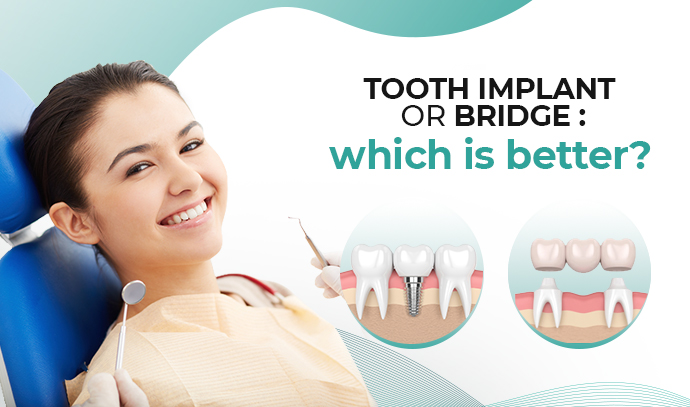
Tooth Implant or Bridge: Which Is Better?
When it comes to replacing missing teeth, tooth implants and dental bridges are two popular options. Both offer their own advantages and are effective solutions for restoring your smile. However, understanding the differences between these two options is crucial in making an informed decision. In this article, we will delve into the intricacies of tooth implants and dental bridges, exploring their benefits, procedures, and factors to consider when choosing between the two.
Understanding Tooth Implant
Tooth implants are artificial tooth roots that are surgically placed into the jawbone. Made of titanium, these implants provide a sturdy foundation for replacement teeth. Dental implants are known for their durability and longevity, often lasting a lifetime with proper care. The implant fuses with the jawbone through a process called osseointegration, ensuring stability and preventing bone loss in the surrounding area.
Benefits of Tooth Implant
One of the major benefits of tooth implants is their ability to mimic natural teeth both in appearance and function. Since the implant is integrated into the jawbone, it offers a strong and stable base for the replacement tooth. This allows for comfortable chewing and speaking without worrying about any slippage or discomfort.
Additionally, tooth implants help to maintain the shape of your face and prevent the sagging that can occur with missing teeth.
Another advantage of tooth implants is that they do not require any alteration of the adjacent healthy teeth. Unlike dental bridges, which rely on the support of neighboring teeth, implants stand on their own, preserving the integrity of your natural teeth.
Furthermore, implants are easy to maintain as they can be treated just like regular teeth. Regular brushing, flossing, and dental check-ups are all that is needed to keep your dental implants in excellent condition.
Procedure for Tooth Implant
The process of getting a tooth implant typically involves multiple stages. Firstly, a comprehensive examination of your oral health is conducted to determine if you are a suitable candidate for the procedure. This may include X-rays and scans to assess the condition of your jawbone and surrounding tissues. If your jawbone is deemed healthy, the implant surgery can proceed.
During the surgery, a small incision is made in the gum tissue to expose the jawbone. A hole is then drilled into the bone, and the implant is carefully placed. Over the course of a few months, osseointegration occurs, allowing the implant to fuse with the bone. Once the implant has fully integrated, an abutment is attached to the implant, and a custom-made crown is placed on top, completing the restoration.
Understanding Dental Bridge
Dental bridges, as the name suggests, bridge the gap left by missing teeth. They consist of one or more artificial teeth, known as pontics, which are held in place by dental crowns attached to the adjacent healthy teeth. Bridges can be made from various materials, including porcelain, metal, or a combination of both. They are a popular choice for patients who are not suitable candidates for dental implants or who prefer a non-invasive procedure.
Benefits of Dental Bridge
One of the advantages of dental bridges is their ability to restore your smile and improve your ability to chew and speak effectively.
By filling in the gaps left by missing teeth, bridges can enhance your overall oral function and prevent adjacent teeth from shifting out of place.
Additionally, dental bridges offer a quicker solution compared to dental implants. In some cases, the entire process can be completed within a few weeks, allowing you to enjoy a complete smile in a shorter timeframe.
Procedure for Dental Bridge
The procedure for getting a dental bridge typically involves two or more dental visits. During the initial visit, the adjacent healthy teeth are prepared by removing a small portion of their enamel. This is necessary to create space for the dental crowns that will hold the bridge in place. Impressions of your teeth are then taken and sent to a dental laboratory, where the bridge will be custom-made to fit your mouth precisely.
Once the bridge is ready, you will return for a second visit to have it fitted and adjusted. The dentist will ensure that the bridge fits comfortably and that your bite is aligned properly. With the bridge in place, you can enjoy the benefits of a complete smile and improved oral function.
Factors to Consider When Choosing Between Tooth Implant and Bridge
When deciding between a tooth implant and a dental bridge, several factors should be taken into consideration. Firstly, the health of your jawbone is crucial. Dental implants require a sufficient amount of healthy bone to ensure successful integration. If your jawbone has deteriorated significantly, bone grafting may be necessary before implants can be placed. In such cases, a dental bridge may be a more suitable option.
Additionally, cost is a significant factor to consider. Dental implants tend to be more expensive than dental bridges, mainly due to the complexity of the procedure and the materials used. However, it is important to weigh the long-term benefits against the initial cost. Dental implants offer a permanent solution and can be a worthwhile investment in your oral health.
The location of the missing teeth is also important to consider. Dental bridges are more suitable for patients who have multiple missing teeth in a row, as they can be supported by the adjacent healthy teeth. Conversely, dental implants are versatile and can be used to replace a single tooth or multiple teeth at different locations in the mouth.
Book an Appointment Today With Elite Dental
If you are considering tooth implants or dental bridges, it is essential to consult with a qualified dental professional. Elite Dental, the best dental implant clinic in Calicut, can provide personalized advice and guide you through the decision-making process. Our experienced team will assess your oral health and help you determine the most suitable treatment option for your needs. Contact Elite Dental today to book an appointment and take the first step towards restoring your smile.
Have Dental Problem : Call us
CALICUT: +91 9745 072 555,
KOCHI: +91 9567 124 888
KANNUR: +91 9645874777
or make an Appointment
Take a smiling selfie and we'll Simulate your new smile See What Invisalign treatment could do for you!




